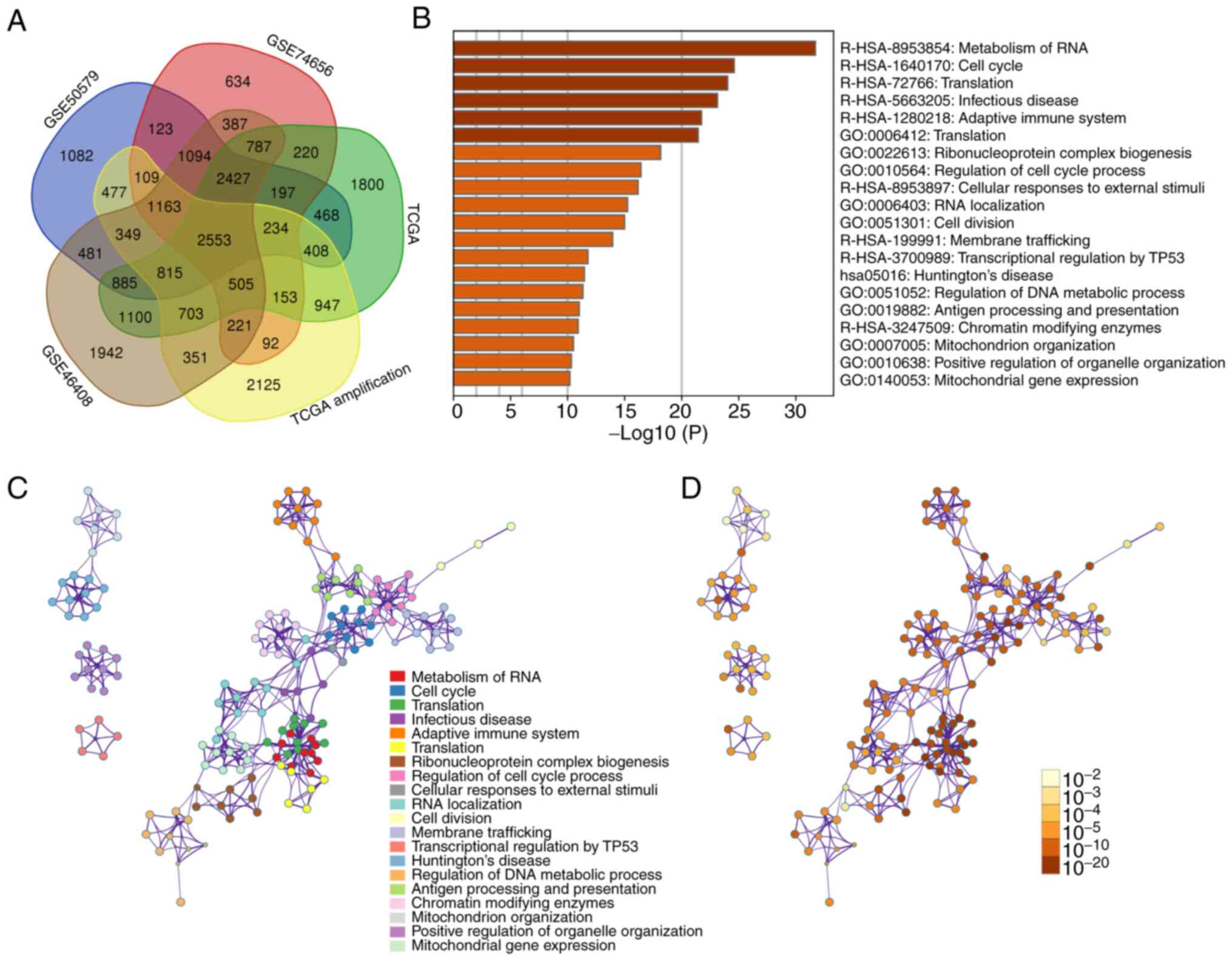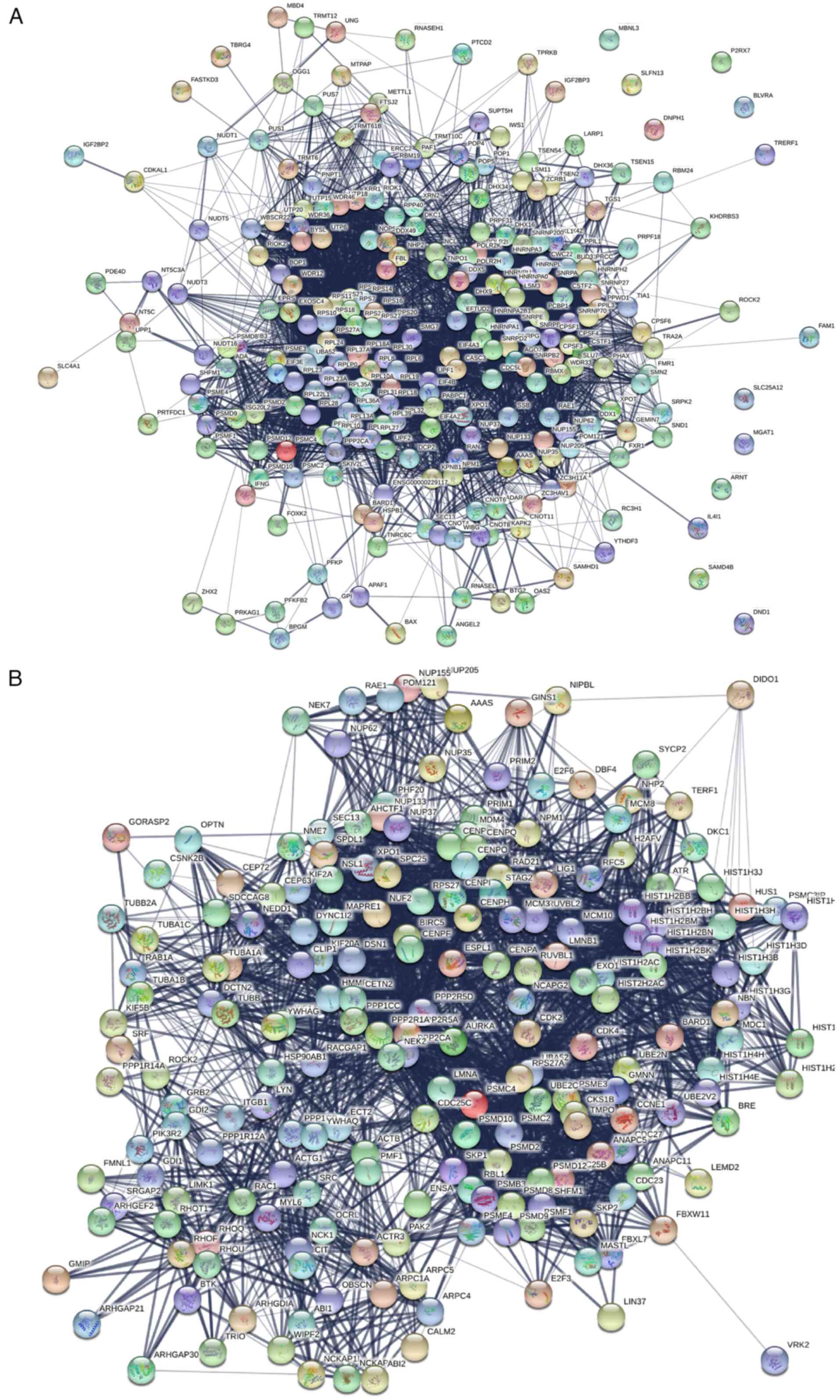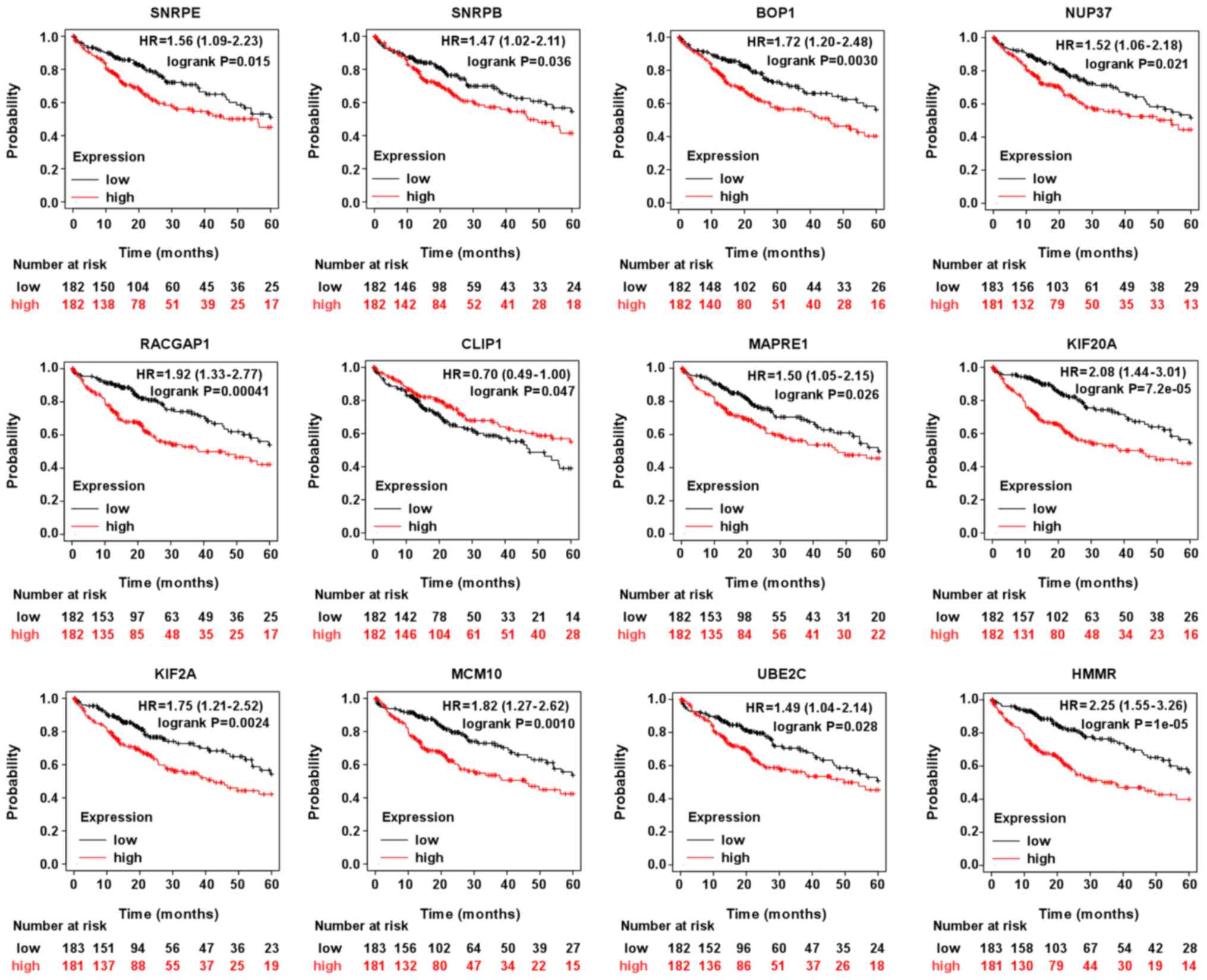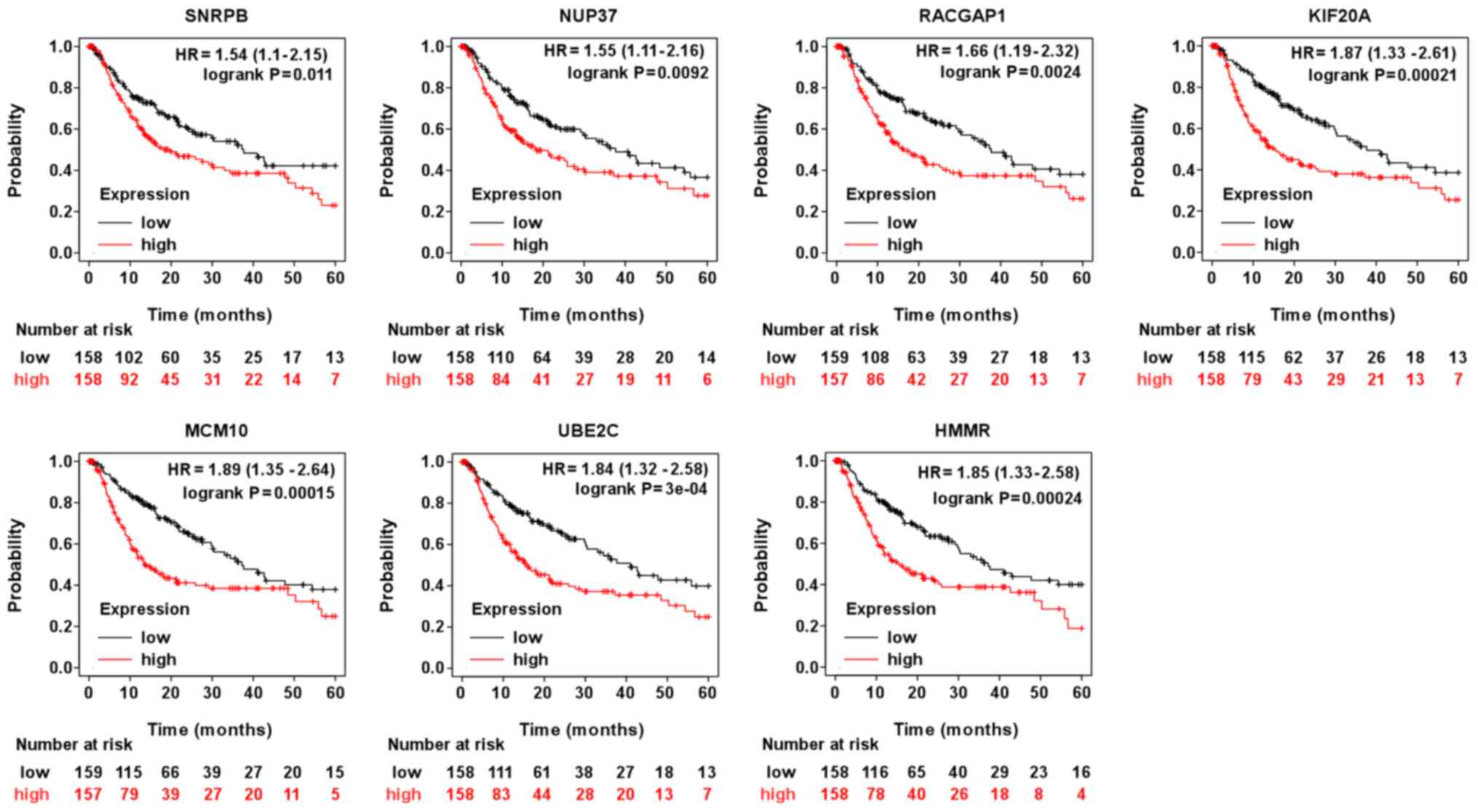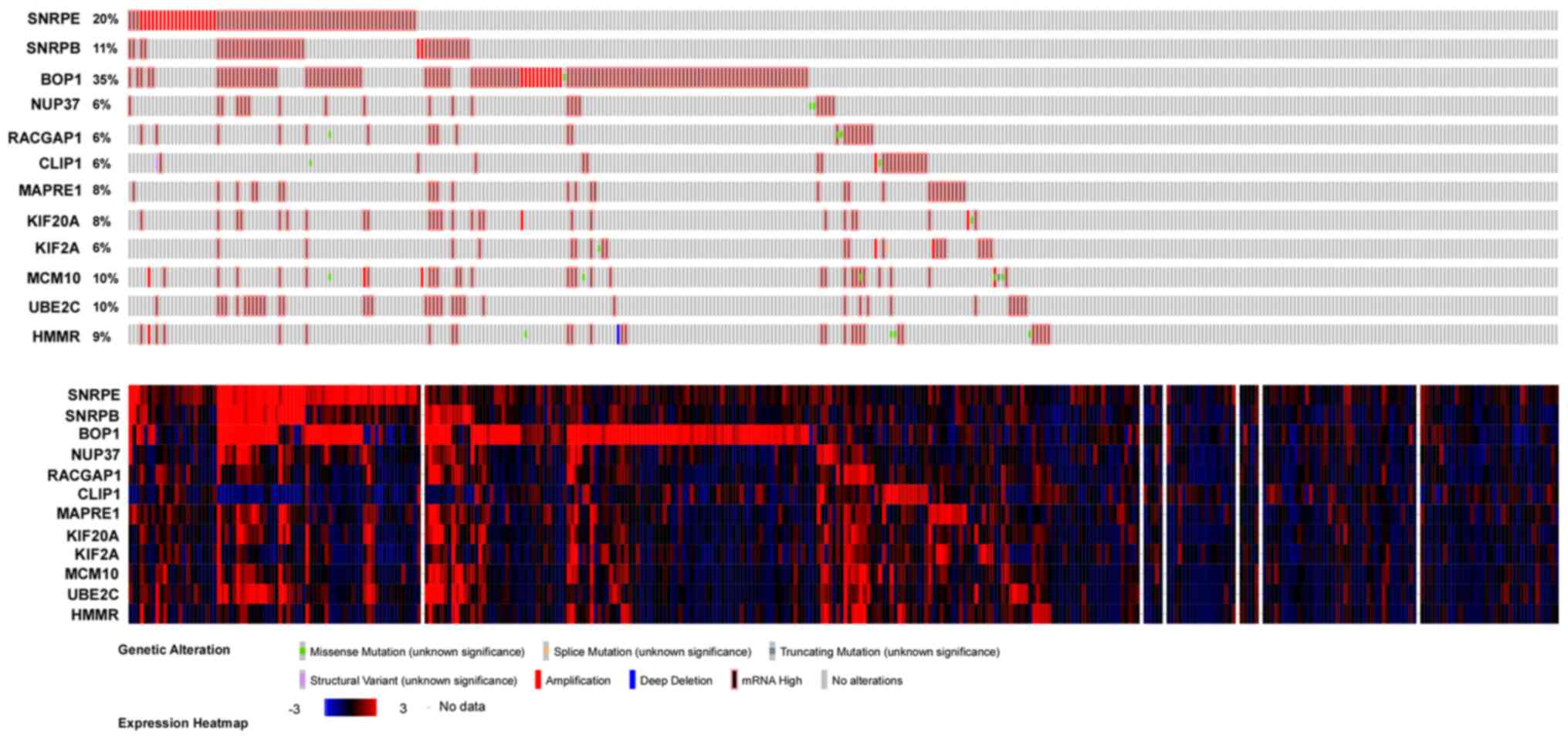Identification of potential biomarkers for diagnosis of hepatocellular carcinoma
- Authors:
- Published online on: November 15, 2021 https://doi.org/10.3892/etm.2021.10973
- Article Number: 51
-
Copyright: © Liang et al. This is an open access article distributed under the terms of Creative Commons Attribution License.
Abstract
Introduction
Liver cancer was the sixth most commonly diagnosed cancer type and the fourth leading cause of cancer-associated death worldwide in 2018. Annually, ~841,000 new cases of liver cancer are diagnosed and 782,000 deaths are recorded (1). In China, liver cancer is the most commonly diagnosed cancer and the leading cause of cancer-associated death in males below the age of 60 years (2).
Hepatocellular carcinoma (HCC) accounts for 75-85% of primary liver cancer cases. Despite enormous progress in medical technologies such as surgical resection, liver transplantation, radiation and chemotherapy in recent decades, the 5-year overall survival rate for HCC remains <30% (3). Therefore, detailed mechanistic information on the tumorigenesis and progression HCC is increasingly required in order to develop more effective therapeutic strategies.
The identification of abnormally expressed genes between normal liver tissues and HCC tissues is a viable strategy for investigating the mechanisms of HCC tumorigenesis and progression. Furthermore, such differentially expressed genes (DEGs) may serve as prognostic markers for HCC. The National Center for Biotechnology Information (NCBI) Gene Expression Omnibus (GEO, http://www.ncbi.nlm.gov/geo/) is a free public repository for high-throughput gene expression data and offers submission, storage and retrieval of microarray, next-generation sequencing and other forms of functional genomic datasets (4-6). The Cancer Genome Atlas (TCGA; http://cancergenome.nih.gov/) provides both clinical and molecular data on >11,000 samples across 33 different tumor types (7). A particular advantage of the GEO and TCGA is that the data therein are collected from different independent researchers and may be integrated and applied, allowing for highly robust analyses.
The most fundamental characteristic of cancer cells is their sustained continuous proliferation, which is due to dysregulation of the cell cycle. Normal cells carefully control the release of growth-promoting signals and subtly regulate the progression of the cell cycle. However, cancer cells exhibit disrupted homeostasis, resulting in malignant proliferation, which induces the loss of normal tissue architecture and function (8).
RNA metabolism (including RNA maturation, degradation and turnover and quality control), as a mediator of regulation, is required for a wide variety of biological processes. This notably includes cell proliferation, where actively proliferating cells must double their macromolecular contents and divide into two daughter cells, necessitating an increase in the biosynthesis of RNA and other molecules. However, despite their functional importance, the metabolism of RNA and the cell cycle receive less research attention than genomics and functional genomics (9). Therefore, information on the genes involved in the metabolism of RNA and the cell cycle, and specifically their involvement in HCC, is urgently required.
In the present study, DEGs were initially screened using multiple GEO microarrays and the TCGA dataset. Subsequently, enrichment analysis and protein-protein interaction (PPI) network analysis were performed. Accordingly, the amplification, increased expression and prognostic value of several central node genes were identified.
Materials and methods
Data sources
The data of the gene expression levels and DNA copy numbers between HCC and control samples were obtained from the NCBI GEO and TCGA datasets. The GEO microarray accession numbers were GSE46408, GSE50579 and GSE74656. All included datasets met the following criteria: i) They employed human liver tissue samples; ii) they contained case-control groups; and iii) they contained at least ten samples. The platform for GSE46408 was the Agilent-014850 Whole Human Genome Microarray 4x44K G4112F (Human 1A Oligo Chip V2;Welgene Biotech Co, Ltd.) and the samples comprised six pairs of HCC and their corresponding non-tumor liver parenchyma tissues. The platform for GSE50579 was the Agilent-028004 SurePrint G3 Human GE 8x60K Microarray (Agilent Technologies 2100 Bioanalyzer; Agilent Technologies Deutchland GmbH) and the samples comprised seven normal liver tissues and 61 HCC tissues. The platform for GSE74656 was the GeneChip® PrimeView™ Human Gene Expression Array (with External spike-in RNAs), which contained five non-tumor HCC tissues. Furthermore, the data for 53 normal liver tissues and 351 HCC tissues were obtained from TCGA for analysis. Only upregulated genes at the RNA level with a fold-change of >2 and P<0.05 were considered.
Dataset analysis
Functional enrichment analysis of common DEGs was performed using the Metascape dataset (http://metascape.org/gp/index.html#/main/step1) according to methods described previously (10). A PPI network was constructed using the Search Tool for the Retrieval of Interacting Genes/proteins (STRING) online database (http://string-bd.org). The prognostic value of mRNA for HCC was assessed using the public online tool Kaplan-Meier Plotter (www.kmplot.com) according to methods described previously (11). The gene mRNA heatmap and DNA amplification numbers for small nuclear ribonucleoprotein polypeptide E (SNRPE), small nuclear ribonucleoprotein polypeptide B and B1 (SNRPB), BOP1 ribosomal biogenesis factor (BOP1), nucleoporin 37 (NUP37), Rac GTPase activating protein 1 (RACGAP1), CAP-Gly domain containing linker protein 1 (CLIP1), microtubule associated protein RP/EB family member 1 (MAPRE1), kinesin family member 20A (KIF20A), kinesin family member 2A (KIF2A), minichromosome maintenance 10 replication initiation factor (MCM10), ubiquitin conjugating enzyme E2 C (UBE2C) and hyaluronan mediated motility receptor (HMMR) were obtained from cBioPortal (http://www.cbioportal.org/).
Overall survival and progression-free survival curves were plotted by the Kaplan-Meier method with Kaplan-Meier Plotter (www.kmplot.com) using a Cox regression model and compared using the log-rank test, and the median expression level was used as the cut-off to stratify the patients into high and low expression groups.
Results
DEGs in the GSE50579, GSE74656, GSE46408 and TCGA datasets
Venn diagram was used to analyze the upregulated genes between HCC and normal controls from different studies. Since somatic copy number alterations are associated with cancer and have been suggested as a specific therapeutic target (12), upregulated genes whose DNA copy numbers are increased in HCC were screened. The downregulated genes were ignored, as our group intends to conduct further studies to investigate whether targeting these upregulated genes may be applied to HCC therapy. According to the above-mentioned principles, a total of 2,553 upregulated genes were identified from GSE50579, GSE74656, GSE46408 and TCGA along with amplified genes in TCGA (Fig. 1A).
Subsequently, functional enrichment analysis of these upregulated genes was performed using Metascape. As indicated in Fig. 1B, metabolism of RNA and the cell cycle were the most commonly enriched terms. Enrichment networks were also established by representing each enriched term as a node and a neighboring node with Kappa similarities of >0.3. Nodes are colored to represent their cluster memberships (Fig. 1C) or statistical P-values (Fig. 1D).
Identification of key candidate genes for diagnosis of HCC
The genes enriched in the metabolism of RNA and the cell cycle were used to perform a PPI network analysis using the STRING database (Fig. 2). In addition, the central node genes were identified. For the metabolism of RNA, the genes with >50 connections/interactions were further studied. The 22 most connected genes were ribosomal protein S 5, RPS28, RPS19, RPS10, RPS13, RPS20, ribosomal protein L27, UPF1 RNA helicase and ATPase, ribosomal protein lateral stalk subunit P0, RPL28, cleavage and polyadenylation specific factor 1, RPL18, SNRPE, SNRPB, ubiquitin A-52 residue ribosomal protein fusion product 1 (UBA52), protein phosphatase 2 catalytic subunit alpha (PPP2CA), RPL30, ribosomal protein L26 like 1, ribosomal protein S18, BOP1, RPL23 and RNA polymerase II, I and III subunit H (Table I). Furthermore, univariate Cox regression was performed to establish whether the above genes may serve as predictors for overall survival and progression-free survival using data from the Kaplan-Meier Plotter dataset, and sources for the database include GEO, EGA and TCGA. The median of mRNA level in the tumor samples was used as a cut-off to stratify the patients into high and low expression groups. As presented in Table I, only SNRPE, SNRPB and BOP1 were associated with the overall survival of patients with HCC. Specifically, patients with HCC and high mRNA levels for SNRPE, SNRPB or BOP1 had poorer overall survival than those with low levels of SNRPE or BOP1 (Table I; Fig. 3). However, only SNRPB appeared to be associated with progression-free survival of patients with HCC (Fig. 4).
Table IPrognostic value of mRNA levels of the key genes from PPI (enriched in metabolism of RNA) for overall survival of patients with hepatocellular carcinoma using the Kaplan-Meier Plotter dataset. |
Next, the expression profiles of SNRPE, SNRPB or BOP1 and their DNA alteration were analyzed using the cBioPortal dataset (Fig. 5). The results showed that their DNA are both amplified.
In terms of the cell cycle, the genes with >50 connections/interactions were further studied, and the top 23 central node genes were subjected to univariate Cox regression analysis to determine their predictive value for overall survival
These were PPP2CA, UBA52, MCM3, protein phosphatase 2 regulatory subunit B'delta, NUP37, dynein cytoplasmic 1 intermediate chain 2, RACGAP1, H2B clustered histone 15, cell division cycle 27, CLIP1, H2B clustered histone 3, exportin 1, actin gamma 1, histone cluster 1, H2bm, MAPRE1, proteasome 20S subunit beta 3, KIF20A, KIF2A, MCM10, DSN1 component of MIS12 kinetochore complex, UBE2C and HMMR (Table II). The analysis indicated that NUP37, RACGAP1, CLIP1, MAPRE1, KIF20A, KIF2A, MCM10, UBE2C and HMMR might serve as the prognostic markers for overall survival (Table II; Fig. 3). While, NUP37, RACGAP1, KIF20A, MCM10, UBE2C and HMMR also were closely correlated with progression-free survival for patients with HCC, suggesting these genes might also serve as prognostic markers for progression-free survival for patients with HCC (Fig. 4). As presented in Fig. 5, the expression profile of MCM3, RACGAP1, MAPRE1, KIF20A, KIF2A, MCM10 and HMMR and DNA alteration of these genes were analyzed using the cBioPortal dataset. The results showed that their DNA are all amplified.
Table IIPrognostic value of mRNA levels of the key genes from the PPI (enriched in cell cycle) for overall survival of patients with hepatocellular carcinoma using the Kaplan-Meier Plotter dataset. |
Discussion
The tumorigenesis and progression of HCC involve a multistep process during which cells undergo complex changes, including accumulating mutations, which lead to activation of oncogenes and loss of tumor suppressor genes. These genes are implicated in multiple pathways that may regulate different steps of carcinogenesis. For instance, certain steps are essential for driving cell transformation, while others have indispensable roles in cancer progression or in the acquisition of characteristics required for metastasis (13). Therefore, identifying such genes is crucial for cancer therapy. However, HCC cells are morphologically and genetically heterogeneous. This heterogeneity partly accounts for the complexity of HCC (14). Therefore, in view of this complexity, it is important to integrate data from different independent studies in order to perform robust analyses.
Accordingly, in the present study, DEGs were identified from GEO and TCGA datasets. Functional enrichment analysis revealed that these genes were mainly associated with RNA metabolism and the cell cycle.
A portion of the genome is known to be transcribed into RNAs, whose biological functions are still being determined. In view of the importance of RNAs, there is a significant turnover of RNAs associated with cell maintenance, repair and modulation, even in quiescent cells. Proliferating cells must upregulate the biosynthesis of RNA and DNA to support cell division (9,15-18). Sustained chronic proliferation is the most fundamental characteristic of cancer cells (8). The proliferation of cancer cells necessitates the upregulation of RNA biosynthesis. In line with this, the present study demonstrated that the DEGs were mainly involved in RNA metabolism. Furthermore, it is widely accepted that the sustained proliferation of cancer cells is realized through deregulation of the cell cycle (19). Accordingly, in the present study, it was indicated that the upregulated genes were also implicated in the cell cycle.
PPI network analysis offers more detailed information on the connections among the upregulated genes in HCC samples. Three genes associated with the overall survival of HCC patients, i.e., SNRPE, SNRPB and BOP1, which are involved in the metabolism of RNA, were screened. SNRPE and SNRPB are a central component of U small nuclear ribonucleoproteins, which are the main components of pre-mRNA processing spliceosomes. It has been reported that SNRPE promotes the proliferation of HCC cells (20). BOP1 is a nucleolar protein that is involved in ribosomal RNA processing and ribosome assembly. It has been reported that it promotes epithelial-to-mesenchymal transition (21).
In a similar manner, seven genes, i.e., NUP37, RACGAP1, CLIP1, MAPRE1, KIF20A, KIF2A, MCM10, UBE2C and HMMR, which regulate the cell cycle in HCC, were screened. Their high expression indicated poor prognosis for patients with HCC. MCM10 belongs to the MCM protein, which is involved in the initiation of eukaryotic genome replication. Their deregulation is observed in multiple cancer types, including prostate cancer (22), HCC (23-25) and renal cell carcinoma (26). RACGAP1 is a GTPase-activating protein that is a component of the central spindlin complex. It is able to bind to activated forms of Rho GTPases and stimulates GTP hydrolysis to induce negative regulation of Rho-mediated signals. It has been reported that high RACGAP1 is correlated with a high rate of post-resection recurrent HCC and may be used as a potential molecular target in the design of therapeutic methods for HCC (27). Furthermore, RACGAP1 participates in the progression of multiple cancer types (28-31).
MAPRE1 belongs to the RP/EB family and was organically identified by its binding with the APC protein. It is involved in the modulation of microtubule structures and chromosome stability. Its deregulation is associated with various cancer types, including colorectal cancer (32), gastric cancer (33), acute lymphoblastic leukemia (34) and HCC (35).
KIF2A and KIF20A belong to the kinesin family, which is a plus end-directed motor required for normal mitotic progression. Their deregulation is implicated in multiple cancer types (36-40).
HMMR forms a complex with BRCA1 and BRCA2 to regulate cell motility. It has been documented that HMMR maintains the stemness and tumorigenicity of glioblastoma stem-like cells (41). Another study has indicated that HMMR may be used as a biomarker for neutropenia induced by chemotherapy in patients with breast cancer (42).
All of these genes are highly interacting/connected genes, suggesting that they may have important roles in HCC. Since they regulate RNA metabolism and cell cycle, targeting them as a cancer therapy would not be specific and would, therefore, be expected to have severe side effects. However, they are significantly associated with overall survival for patients with HCC; therefore, they may serve as prognosis markers for patients with HCC. As another limitation, only a univariate analysis was performed to determine the association of these genes with survival, while multivariate analysis of single genes, or of a combined gene signature, may have provided an independent prognostic marker, which might provide more valuable for prognosis of HCC, and should be provided in a future study.
Acknowledgements
Not applicable.
Funding
Funding: This work was supported by grants from the Science and Technology Projects Foundation of Guangzhou City (grant nos. 201804010416 and 201904010355) and the Guangzhou Zengcheng District Science and Technology Innovation Project (grant no. 2021049).
Availability of data and materials
The datasets used and/or analyzed during the present study are available from the corresponding author on reasonable request.
Authors' contributions
XHL and ZPF designed the study. FQL, RY, LYY, HS and HLL completed the data acquisition and analysis. ZPF wrote the manuscript. All authors have read and approved the final version of the manuscript. ZPF, XHL, FQL, RY, LYY, HS and HLL confirm the authenticity of all the raw data.
Ethics approval and consent to participate
Not applicable.
Patient consent for publication
Not applicable.
Competing interests
The authors declare that they have no competing interests.
References
|
Bray F, Ferlay J, Soerjomataram I, Siegel RL, Torre LA and Jemal A: Global cancer statistics 2018: GLOBOCAN estimates of incidence and mortality worldwide for 36 cancers in 185 countries. CA Cancer J Clin. 68:394–424. 2018.PubMed/NCBI View Article : Google Scholar | |
|
Chen W, Zheng R, Baade PD, Zhang S, Zeng H, Bray F, Jemal A, Yu XQ and He J: Cancer statistics in China, 2015. CA Cancer J Clin. 66:115–132. 2016.PubMed/NCBI View Article : Google Scholar | |
|
Han D, Li J, Wang H, Su X, Hou J, Gu Y, Qian C, Lin Y, Liu X, Huang M, et al: Circular RNA circMTO1 acts as the sponge of microRNA-9 to suppress hepatocellular carcinoma progression. Hepatology. 66:1151–1164. 2017.PubMed/NCBI View Article : Google Scholar | |
|
Barrett T and Edgar R: Mining microarray data at NCBI's Gene Expression Omnibus (GEO)*. Methods Mol Biol. 338:175–190. 2006.PubMed/NCBI View Article : Google Scholar | |
|
Clough E and Barrett T: The Gene Expression Omnibus Database. Methods Mol Biol. 1418:93–110. 2016.PubMed/NCBI View Article : Google Scholar | |
|
Edgar R, Domrachev M and Lash AE: Gene Expression Omnibus: NCBI gene expression and hybridization array data repository. Nucleic Acids Res. 30:207–210. 2002.PubMed/NCBI View Article : Google Scholar | |
|
Wei L, Jin Z, Yang S, Xu Y, Zhu Y and Ji Y: TCGA-assembler 2: Software pipeline for retrieval and processing of TCGA/CPTAC data. Bioinformatics. 34:1615–1617. 2018.PubMed/NCBI View Article : Google Scholar | |
|
Hanahan D and Weinberg RA: Hallmarks of cancer: The next generation. Cell. 144:646–674. 2011.PubMed/NCBI View Article : Google Scholar | |
|
Lane AN and Fan TW: Regulation of mammalian nucleotide metabolism and biosynthesis. Nucleic Acids Res. 43:2466–2485. 2015.PubMed/NCBI View Article : Google Scholar | |
|
Zhou Y, Zhou B, Pache L, Chang M, Khodabakhshi AH, Tanaseichuk O, Benner C and Chanda SK: Metascape provides a biologist-oriented resource for the analysis of systems-level datasets. Nat Commun. 10(1523)2019.PubMed/NCBI View Article : Google Scholar | |
|
Győrffy B, Surowiak P, Budczies J and Lánczky A: Online survival analysis software to assess the prognostic value of biomarkers using transcriptomic data in non-small-cell lung cancer. PLoS One. 8(e82241)2013.PubMed/NCBI View Article : Google Scholar | |
|
Zhou CC, Yang F, Yuan SX, Ma JZ, Liu F, Yuan JH, Bi FR, Lin KY, Yin JH, Cao GW, et al: Systemic genome screening identifies the outcome associated focal loss of long noncoding RNA PRAL in hepatocellular carcinoma. Hepatology. 63:850–863. 2016.PubMed/NCBI View Article : Google Scholar | |
|
Imbeaud S, Ladeiro Y and Zucman-Rossi J: Identification of novel oncogenes and tumor suppressors in hepatocellular carcinoma. Semin Liver Dis. 30:75–86. 2010.PubMed/NCBI View Article : Google Scholar | |
|
Spangenberg HC, Thimme R and Blum HE: Targeted therapy for hepatocellular carcinoma. Nat Rev Gastroenterol Hepatol. 6:423–432. 2009.PubMed/NCBI View Article : Google Scholar | |
|
Hangauer MJ, Vaughn IW and McManus MT: Pervasive transcription of the human genome produces thousands of previously unidentified long intergenic noncoding RNAs. PLoS Genet. 9(e1003569)2013.PubMed/NCBI View Article : Google Scholar | |
|
Djebali S, Davis CA, Merkel A, Dobin A, Lassmann T, Mortazavi A, Tanzer A, Lagarde J, Lin W, Schlesinger F, et al: Landscape of transcription in human cells. Nature. 489:101–108. 2012.PubMed/NCBI View Article : Google Scholar | |
|
Consortium EP: ENCODE Project Consortium. An integrated encyclopedia of DNA elements in the human genome. Nature. 489:57–74. 2012.PubMed/NCBI View Article : Google Scholar | |
|
Sigoillot FD, Berkowski JA, Sigoillot SM, Kotsis DH and Guy HI: Cell cycle-dependent regulation of pyrimidine biosynthesis. J Biol Chem. 278:3403–3409. 2003.PubMed/NCBI View Article : Google Scholar | |
|
Urrego D, Tomczak AP, Zahed F, Stühmer W and Pardo LA: Potassium channels in cell cycle and cell proliferation. Philos Trans R Soc Lond B Biol Sci. 369(20130094)2014.PubMed/NCBI View Article : Google Scholar | |
|
Jia D, Wei L, Guo W, Zha R, Bao M, Chen Z, Zhao Y, Ge C, Zhao F, Chen T, et al: Genome-wide copy number analyses identified novel cancer genes in hepatocellular carcinoma. Hepatology. 54:1227–1236. 2011.PubMed/NCBI View Article : Google Scholar | |
|
Chung KY, Cheng IK, Ching AK, Chu JH, Lai PB and Wong N: Block of proliferation 1 (BOP1) plays an oncogenic role in hepatocellular carcinoma by promoting epithelial-to-mesenchymal transition. Hepatology. 54:307–318. 2011.PubMed/NCBI View Article : Google Scholar | |
|
Cui F, Hu J, Ning S, Tan J and Tang H: Overexpression of MCM10 promotes cell proliferation and predicts poor prognosis in prostate cancer. Prostate. 78:1299–1310. 2018.PubMed/NCBI View Article : Google Scholar | |
|
Liu Z, Li J, Chen J, Shan Q, Dai H, Xie H, Zhou L, Xu X and Zheng S: MCM family in HCC: MCM6 indicates adverse tumor features and poor outcomes and promotes S/G2 cell cycle progression. BMC Cancer. 18(200)2018.PubMed/NCBI View Article : Google Scholar | |
|
Zhuang L, Yang Z and Meng Z: Upregulation of BUB1B, CCNB1, CDC7, CDC20, and MCM3 in tumor tissues predicted worse overall survival and disease-free survival in hepatocellular carcinoma patients. BioMed Res Int. 2018(7897346)2018.PubMed/NCBI View Article : Google Scholar | |
|
Yang Q, Xie B, Tang H, Meng W, Jia C, Zhang X, Zhang Y, Zhang J, Li H and Fu B: Minichromosome maintenance 3 promotes hepatocellular carcinoma radioresistance by activating the NF-κB pathway. J Exp Clin Cancer Res. 38(263)2019.PubMed/NCBI View Article : Google Scholar | |
|
Gao Z, Man X, Li Z, Bi J, Liu X, Li Z, Li J, Zhang Z and Kong C: PLK1 promotes proliferation and suppresses apoptosis of renal cell carcinoma cells by phosphorylating MCM3. Cancer Gene Ther. 27:412–423. 2020.PubMed/NCBI View Article : Google Scholar | |
|
Wang SM, Ooi LL and Hui KM: Upregulation of Rac GTPase-activating protein 1 is significantly associated with the early recurrence of human hepatocellular carcinoma. Clin Cancer Res. 17:6040–6051. 2011.PubMed/NCBI View Article : Google Scholar | |
|
Wang C, Wang W, Liu Y, Yong M, Yang Y and Zhou H: Rac GTPase activating protein 1 promotes oncogenic progression of epithelial ovarian cancer. Cancer Sci. 109:84–93. 2018.PubMed/NCBI View Article : Google Scholar | |
|
Mi S, Lin M, Brouwer-Visser J, Heim J, Smotkin D, Hebert T, Gunter MJ, Goldberg GL, Zheng D and Huang GS: RNA-seq Identification of RACGAP1 as a Metastatic Driver in Uterine Carcinosarcoma. Clin Cancer Res. 22:4676–4686. 2016.PubMed/NCBI View Article : Google Scholar | |
|
Imaoka H, Toiyama Y, Saigusa S, Kawamura M, Kawamoto A, Okugawa Y, Hiro J, Tanaka K, Inoue Y, Mohri Y, et al: RacGAP1 expression, increasing tumor malignant potential, as a predictive biomarker for lymph node metastasis and poor prognosis in colorectal cancer. Carcinogenesis. 36:346–354. 2015.PubMed/NCBI View Article : Google Scholar | |
|
Saigusa S, Tanaka K, Mohri Y, Ohi M, Shimura T, Kitajima T, Kondo S, Okugawa Y, Toiyama Y, Inoue Y, et al: Clinical significance of RacGAP1 expression at the invasive front of gastric cancer. Gastric Cancer. 18:84–92. 2015.PubMed/NCBI View Article : Google Scholar | |
|
Taguchi A, Rho JH, Yan Q, Zhang Y, Zhao Y, Xu H, Tripathi SC, Wang H, Brenner DE, Kucherlapati M, et al: MAPRE1 as a plasma biomarker for early-stage colorectal cancer and adenomas. Cancer Prev Res (Phila). 8:1112–1119. 2015.PubMed/NCBI View Article : Google Scholar | |
|
Kim K, Lee HC, Park JL, Kim M, Kim SY, Noh SM, Song KS, Kim JC and Kim YS: Epigenetic regulation of microRNA-10b and targeting of oncogenic MAPRE1 in gastric cancer. Epigenetics. 6:740–751. 2011.PubMed/NCBI View Article : Google Scholar | |
|
Fu JF, Hsu HC and Shih LY: MLL is fused to EB1 (MAPRE1), which encodes a microtubule-associated protein, in a patient with acute lymphoblastic leukemia. Genes Chromosomes Cancer. 43:206–210. 2005.PubMed/NCBI View Article : Google Scholar | |
|
Chen RX, Song HY, Dong YY, Hu C, Zheng QD, Xue TC, Liu XH, Zhang Y, Chen J, Ren ZG, et al: Dynamic expression patterns of differential proteins during early invasion of hepatocellular carcinoma. PLoS One. 9(e88543)2014.PubMed/NCBI View Article : Google Scholar | |
|
Xie T, Li X, Ye F, Lu C, Huang H, Wang F, Cao X and Zhong C: High KIF2A expression promotes proliferation, migration and predicts poor prognosis in lung adenocarcinoma. Biochem Biophys Res Commun. 497:65–72. 2018.PubMed/NCBI View Article : Google Scholar | |
|
Zhang X, Ma C, Wang Q, Liu J, Tian M, Yuan Y, Li X and Qu X: Role of KIF2A in the progression and metastasis of human glioma. Mol Med Rep. 13:1781–1787. 2016.PubMed/NCBI View Article : Google Scholar | |
|
Wang J, Ma S, Ma R, Qu X, Liu W, Lv C, Zhao S and Gong Y: KIF2A silencing inhibits the proliferation and migration of breast cancer cells and correlates with unfavorable prognosis in breast cancer. BMC Cancer. 14(461)2014.PubMed/NCBI View Article : Google Scholar | |
|
Duan J, Huang W and Shi H: Positive expression of KIF20A indicates poor prognosis of glioma patients. OncoTargets Ther. 9:6741–6749. 2016.PubMed/NCBI View Article : Google Scholar | |
|
Stangel D, Erkan M, Buchholz M, Gress T, Michalski C, Raulefs S, Friess H and Kleeff J: Kif20a inhibition reduces migration and invasion of pancreatic cancer cells. J Surg Res. 197:91–100. 2015.PubMed/NCBI View Article : Google Scholar | |
|
Tilghman J, Wu H, Sang Y, Shi X, Guerrero-Cazares H, Quinones-Hinojosa A, Eberhart CG, Laterra J and Ying M: HMMR maintains the stemness and tumorigenicity of glioblastoma stem-like cells. Cancer Res. 74:3168–3179. 2014.PubMed/NCBI View Article : Google Scholar | |
|
Bidadi B, Liu D, Kalari KR, Rubner M, Hein A, Beckmann MW, Rack B, Janni W, Fasching PA, Weinshilboum RM, et al: Pathway-Based Analysis of Genome-Wide Association Data Identified SNPs in HMMR as Biomarker for Chemotherapy- Induced Neutropenia in Breast Cancer Patients. Front Pharmacol. 9(158)2018.PubMed/NCBI View Article : Google Scholar |



